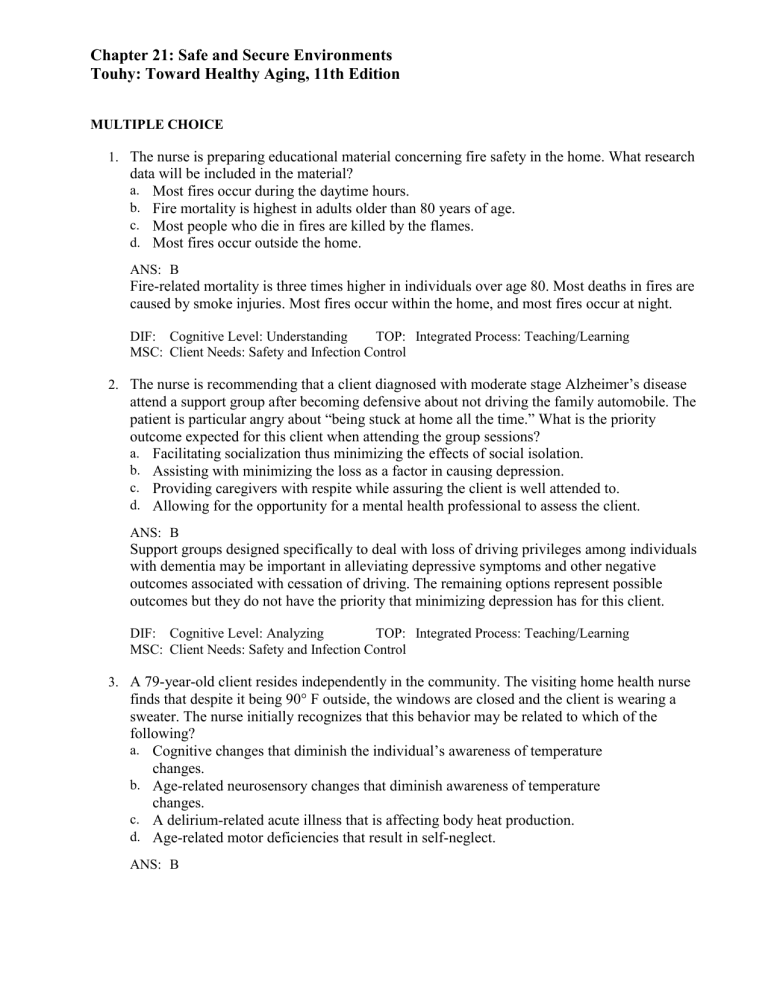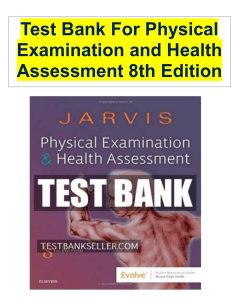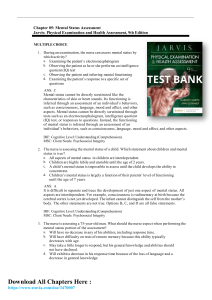
Chapter 21: Safe and Secure Environments Touhy: Toward Healthy Aging, 11th Edition MULTIPLE CHOICE 1. The nurse is preparing educational material concerning fire safety in the home. What research data will be included in the material? a. Most fires occur during the daytime hours. b. Fire mortality is highest in adults older than 80 years of age. c. Most people who die in fires are killed by the flames. d. Most fires occur outside the home. ANS: B Fire-related mortality is three times higher in individuals over age 80. Most deaths in fires are caused by smoke injuries. Most fires occur within the home, and most fires occur at night. DIF: Cognitive Level: Understanding TOP: Integrated Process: Teaching/Learning MSC: Client Needs: Safety and Infection Control 2. The nurse is recommending that a client diagnosed with moderate stage Alzheimer’s disease attend a support group after becoming defensive about not driving the family automobile. The patient is particular angry about “being stuck at home all the time.” What is the priority outcome expected for this client when attending the group sessions? a. Facilitating socialization thus minimizing the effects of social isolation. b. Assisting with minimizing the loss as a factor in causing depression. c. Providing caregivers with respite while assuring the client is well attended to. d. Allowing for the opportunity for a mental health professional to assess the client. ANS: B Support groups designed specifically to deal with loss of driving privileges among individuals with dementia may be important in alleviating depressive symptoms and other negative outcomes associated with cessation of driving. The remaining options represent possible outcomes but they do not have the priority that minimizing depression has for this client. DIF: Cognitive Level: Analyzing TOP: Integrated Process: Teaching/Learning MSC: Client Needs: Safety and Infection Control 3. A 79-year-old client resides independently in the community. The visiting home health nurse finds that despite it being 90° F outside, the windows are closed and the client is wearing a sweater. The nurse initially recognizes that this behavior may be related to which of the following? a. Cognitive changes that diminish the individual’s awareness of temperature changes. b. Age-related neurosensory changes that diminish awareness of temperature changes. c. A delirium-related acute illness that is affecting body heat production. d. Age-related motor deficiencies that result in self-neglect. ANS: B Neurosensory changes related to aging tend to delay or diminish the individual’s awareness of temperature changes and may impair behavior or thermoregulatory responses to dangerously high or low temperatures. There is no evidence in this scenario that the client has cognitive changes, an acute illness, or is incapable of self-care, and such assumptions should not be routinely made based on age alone. DIF: Cognitive Level: Understanding TOP: Integrated Process: Teaching/Learning MSC: Client Needs: Safety and Infection Control 4. A homecare nurse in an area of the country that is prone to tornadoes routinely discusses disaster preparedness with older adult clients. What is the primary rationale for this intervention? a. Older adults are less likely to seek formal and informal help when affected by natural disasters. b. The older adult is more likely to live in a communal environment that provides assistance in times of natural disasters. c. Most older adults have insurance to help them recover from material losses due to a natural disaster. d. Federal and private assistance agencies generally provide older adults with priority attention in time of natural disasters. ANS: A Older adults are less likely to seek assistance than younger adults in times of disaster. The remaining options are not generally proven to be true for the majority of older adults. DIF: Cognitive Level: Understanding TOP: Integrated Process: Teaching/Learning MSC: Client Needs: Safety and Infection Control 5. A homecare nurse visits an older patient who lives in a Naturally Occurring Retirement Community (NORC). The nurse understands that NORCs are identified as what? a. Purpose-built senior housing communities. b. Neighborhoods or buildings where a large segment of the residents are older adults. c. Communities where volunteers coordinate access to services for older adults. d. Intentional collaborative housing where residents participate in the design and operation of the neighborhood. ANS: B NORCs are neighborhoods or buildings where a large number of the residents are older adults. They were not purposely built as senior housing. The residents in a NORC aged in place. The village model is where volunteers coordinate access to affordable care for seniors. Cohousing is an intentional collaborative model where residents participate in the design and operation of the neighborhood. DIF: Cognitive Level: Remembering TOP: Integrated Process: Teaching/Learning MSC: Client Needs: Health Promotion and Maintenance MULTIPLE RESPONSE 1. What information should be included in an informational program to be presented on burn prevention to a senior citizens group? (Select all that apply.) a. Do not smoke in bed or when sleepy. b. Wear well-fitted clothing when cooking or when grilling outdoors. c. Establish a meeting place for all family members outside of the home in case of a fire. d. Establish a plan for exiting each room of your home in the case of a fire. e. Have a fire extinguisher readily available in the kitchen. ANS: A, B, E Measures to prevent burns include not smoking in bed or when sleepy, not wearing loose-fitting clothing (e.g., bathrobes, nightgowns, pajamas) when cooking or around an open heat source, and installing a portable hand fire extinguisher in the kitchen. The remaining options are related to safely evacuating a home in case of a fire. DIF: Cognitive Level: Applying TOP: Integrated Process: Teaching/Learning MSC: Client Needs: Safety and Infection Control 2. Which precaution would be beneficial in minimizing an older adult’s risk of being a victim of fraud? (Select all that apply.) a. Do not allow uninvited salespersons into your home. b. Never provide personal information to telephone sales solicitors. c. Rely on the advice of people who only friends have recommended. d. Contact the local Medicare or Medicaid service office for information when needed. e. Keep your bank account and credit card numbers with you at all times. ANS: A, B, D The correct options provide sound advice, but relying on friends alone for advice may not be prudent while personal information should be kept in a safe place, not necessarily on your person. DIF: Cognitive Level: Applying TOP: Integrated Process: Teaching/Learning MSC: Client Needs: Safety and Infection Control 3. The benefits of telehealth include which of the following? (Select all that apply.) a. Promotes self-management of illness in rural and underserved areas. b. Facilitates remote physical assessment and monitoring of chronic conditions. c. Decreases costs by replacing the role of the nurse with technology. d. Decreases costs by reducing hospital readmissions. e. Is reimbursed by all health care insurances. ANS: A, B, D Telehealth promotes self-management of illness and facilitates remote assessment and monitoring in rural and underserved areas. Evidence has demonstrated that it reduces costs by decreasing hospital readmission. Telehealth does not replace the role of the nurse; the technology augments the ability of the nurse to reach clients in remote areas. Unfortunately, not all health care insurers reimburse for telehealth services. DIF: Cognitive Level: Remembering TOP: Integrated Process: Teaching/Learning MSC: Client Needs: Health Promotion and Maintenance 4. A nurse is caring for a frail older adult in a long-term care facility and is concerned about preventing hypothermia. Which of the following interventions should the nurse implement? (Select all that apply.) a. Make sure that the temperature in the resident’s room is at least 68° F. b. Cover residents well when in bed and while bathing. c. Provide a head covering for the resident. d. Maintain resident in bed covered with heavy blankets at all times. e. Provide hot, high-protein meals and bedtime snacks. ANS: A, B, C, E Interventions to prevent hypothermia in frail elders include maintaining an ambient temperature of no lower than 68° F, providing a head covering whenever possible—in bed, out of bed, and particularly out-of-doors, covering patients well when in bed and when bathing, and providing hot, high-protein meals and bedtime snacks to add heat and sustain heat production throughout the day and as far into the night as possible. In addition, it is important to get the patient out of bed and provide as much exercise as possible to generate heat from muscle activity. DIF: Cognitive Level: Remembering TOP: Integrated Process: Teaching/Learning MSC: Client Needs: Health Promotion and Maintenance 5. The daughter of an older patient says to a nurse, “I am so concerned that my dad is still driving. He is dangerous! He has had a couple of accidents and I am worried that he is going to kill himself or, worse, somebody else. What can I do?” The nurse recommends which of the following involved type action strategies for driving cessation? (Select all that apply.) a. Report the person to the division of motor vehicles for license suspension. b. Hold a family meeting with the person to discuss the situation and come to a mutual agreement of the problem. c. Arrange for alternate transportation for the person. d. Confiscate the keys to the car. e. Ask the patient’s physician to write a prescription for the person to stop driving. ANS: B, C Options B and C are examples of the involved type of action strategies for driving cessation. Options A, D, and E are all examples of the imposed type of action strategies for driving cessation. DIF: Cognitive Level: Analyzing TOP: Integrated Process: Teaching/Learning MSC: Client Needs: Health Promotion and Maintenance

